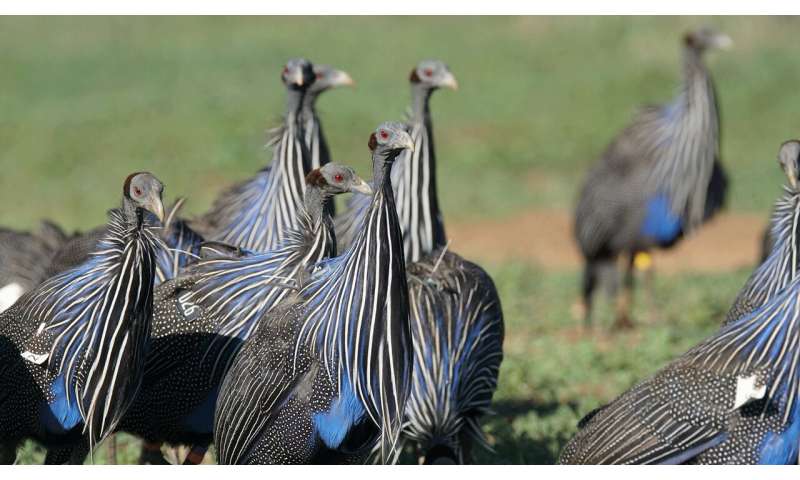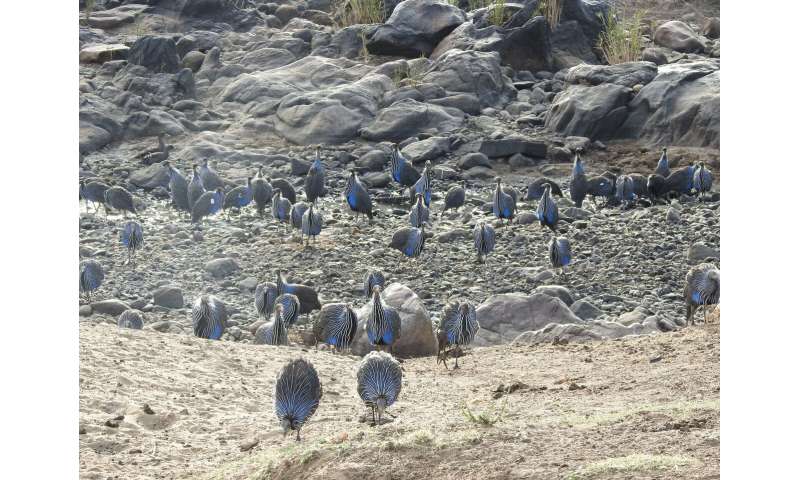Guineafowl (Acryllium vulturinum).
The Vulturine Guineafowl (Acryllium vulturinum) is the largest and most spectacular of the guineafowl bird family, Numididae, and is the only member of the genus Acryllium. It is a resident breeder in northeast Africa, from southern Ethiopia through Kenya and just into northern Tanzania.
It breeds in dry and open habitats with scattered bushes and trees, such as savannah or grassland. It lays its usually 4-8 cream-colored eggs in a well-hidden grass-lined scrape.
Vulturine Guineafowl is a large (61-71cm) bird with a round body and small head. It is longer in the neck, legs and tail than other guineafowl. The adult has a bare blue face and black neck, and although all other guineafowl have unfeathered heads, this species looks particularly like a vulture because of the long heads and neck.
The slim neck projects from a cape of long, glossy, blue and white hackles. The breast is cobalt blue, and the rest of the body plumage is black, finely spangled with white. The wings are short and rounded, and the tail is also short.
Males and females look alike, although the female is usually slightly smaller than the male. Young birds are mainly grey-brown, with a duller blue breast and short hackles.
Vulturine Guineafowl is a gregarious species, forming flocks outside the breeding season typically of about 25 birds. This species' food is seeds and small invertebrates. This guineafowl is terrestrial, and will run rather than fly when alarmed. Despite the open habitat, it tends to keep to cover, and roosts in trees. It makes loud chink-chink-chink-chink-chink calls.
References
BirdLife International (2004). . 2006 IUCN Red List of Threatened Species. IUCN 2006. Retrieved on 11 May 2006. Database entry includes justification for why this species is of least concernPheasants, Partridges and Grouse by Madge and McGowan, ISBN 0-7136-3966-0
www.beautyofbirds.com/vulturineguineafowl.html.
Complex society discovered in the vulturine guineafowl.by Max Planck Society
 Vulturine guineafowl move in highly cohesive groups. This cohesion allows them to coordinate their actions as they move together through the landscape, and therefore maintain stable group membership over extensive periods of time. Credit: James Klarevas
Vulturine guineafowl move in highly cohesive groups. This cohesion allows them to coordinate their actions as they move together through the landscape, and therefore maintain stable group membership over extensive periods of time. Credit: James Klarevas
Multilevel societies have, until now, only been known to exist among large-brained mammals including humans, other primates, elephants, giraffes and dolphins. Now, scientists from the Max Planck Institute of Animal Behavior and the University of Konstanz report the existence of a multilevel society in a small-brained bird, the vulturine guineafowl (Acryllium vulturinum). The study, published in Current Biology, suggests that the birds can keep track of social associations with hundreds of other individuals—challenging the notion that large brains are a requirement for complex societies, and providing a clue as to how these societies evolved.
Multilevel societies occur when social units, such as pairs, of animals form groups that have stable membership, and these groups then associate preferentially with specific other groups. Because this requires the animals to keep track of individuals in both their own and other groups, the assumption has long been that multilevel societies should only exist in species with the intelligence to cope with this complexity. While many bird species live in groups, these are either open, lacking long-term stability, or highly territorial, lacking associations with other groups.
Vulturine guineafowl, however, present a striking exception: The researchers observed these birds, which are from an ancient lineage resembling dinosaurs, behaving highly cohesively without exhibiting the signature intergroup aggression that is common in other group-living birds. And they manage this despite having relatively small brains, even relative to other birds. "They seemed to have the right elements to form complex social structures, and yet nothing was known about them," says Danai Papageorgiou, lead author on the paper and a Ph.D. student at the Max Planck Institute of Animal Behavior.
 Groups of vulturine guineafowl can become very large, and when multiple groups come into contact the number of birds moving together can reach into the hundreds. However, when these 'super-groups' eventually split, they do so back into their original stable group units, meaning that individuals are knowledgeable about who is part of their group and who is not. Credit: Danai Papageorgiou
Groups of vulturine guineafowl can become very large, and when multiple groups come into contact the number of birds moving together can reach into the hundreds. However, when these 'super-groups' eventually split, they do so back into their original stable group units, meaning that individuals are knowledgeable about who is part of their group and who is not. Credit: Danai Papageorgiou
The study, the first ever conducted on the species, involved tracking social relationships over the course of multiple seasons in a population of over 400 adult birds in a field site in Kenya. The researchers individually marked all birds in the population, and discovered that the population comprised 18 distinct social groups (with 13 to 65 individuals in each). What struck the researchers is that these groups remained stable, despite regularly overlapping with one or more other groups both during the day and at night-time roosts. To see if these groups preferentially associated with one another, the researchers attached GPS tags to a sample of individuals in each group. This meant that the position of every single group was recorded continuously each day, which allowed researchers to observe how all 18 groups in the population were interacting simultaneously. The researchers found that groups associated with each other based on preference rather than through random encounters, and also showed that intergroup associations were more likely to take place during specific seasons and around particular physical features in the landscape.
"To our knowledge, this is the first time a social structure like this has been described for birds," says Papageorgiou. "It is remarkable to observe hundreds of birds coming out of a roost and splitting up perfectly into completely stable groups every single day. How do they do that? It's obviously not just about being smart."
Despite being understudied, guineafowl have challenged the understanding of how sociality has evolved. "This discovery raises a lot of questions about the mechanisms underlying complex societies and has opened up exciting possibilities of exploring what is it about this bird that has made them evolve a social system that is in many ways more comparable to a primate than to other birds," says Damien Farine, senior author on the paper and a principal investigator at the Max Planck Institute of Animal Behavior and the Centre for the Advanced Study of Collective Behaviour at the University of Konstanz.
But vulturine guineafowl hold some important clues about how complex societies might have evolved. "Many examples of multilevel societies—primates, elephants and giraffes—might have evolved under similar ecological conditions as vulturine guineafowl," says Farine.
phys.org/news/2019-11-complex-society-vulturine-guineafowl.html
Journal Reference:
Danai Papageorgiou, Charlotte Christensen, Gabriella E.C. Gall, James A. Klarevas-Irby, Brendah Nyaguthii, Iain D. Couzin, Damien R. Farine. The multilevel society of a small-brained bird. Current Biology. DOI: 10.1016/j.cub.2019.09.072
Summary
Animal societies can be organised in multiple hierarchical tiers. Such multilevel societies, where stable groups move together through the landscape, overlapping and associating preferentially with specific other groups, are thought to represent one of the most complex forms of social structure in vertebrates. For example, hamadryas baboons ( Papio hamadryas) live in units consisting of one male and one or several females, or of several solitary males, that group into clans. These clans then come together with solitary bachelor males to form larger bands. This social structure means that individuals have to track many different types of relationships at the same time. Here, we provide detailed quantitative evidence for the presence of a multilevel society in a small-brained bird, the vulturine guineafowl ( Acryllium vulturinum). We demonstrate that this species lives in large, multi-male, multi-female groups that associate preferentially with specific other groups, both during the day and at night-time communal roosts.
www.cell.com/current-biology/fulltext/S0960-9822(19)31263-1?_returnURL=https%3A%2F%2Flinkinghub.elsevier.com%2Fretrieve%2Fpii%2FS0960982219312631%3Fshowall%3DtrueEaglehawk posted the 2nd account on my forum.